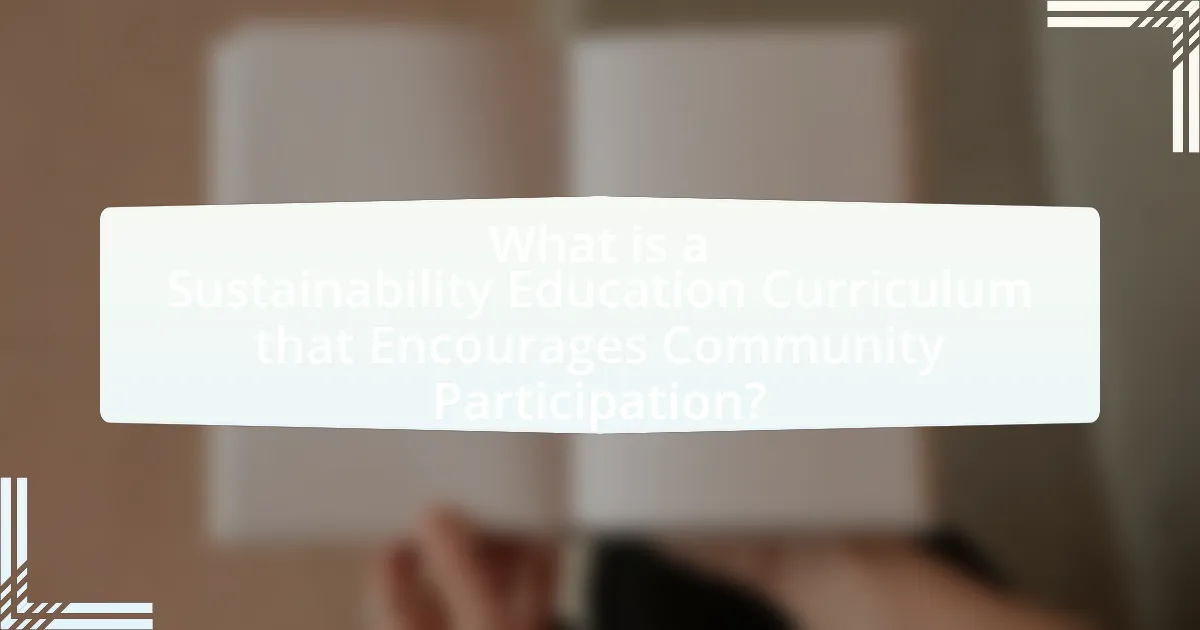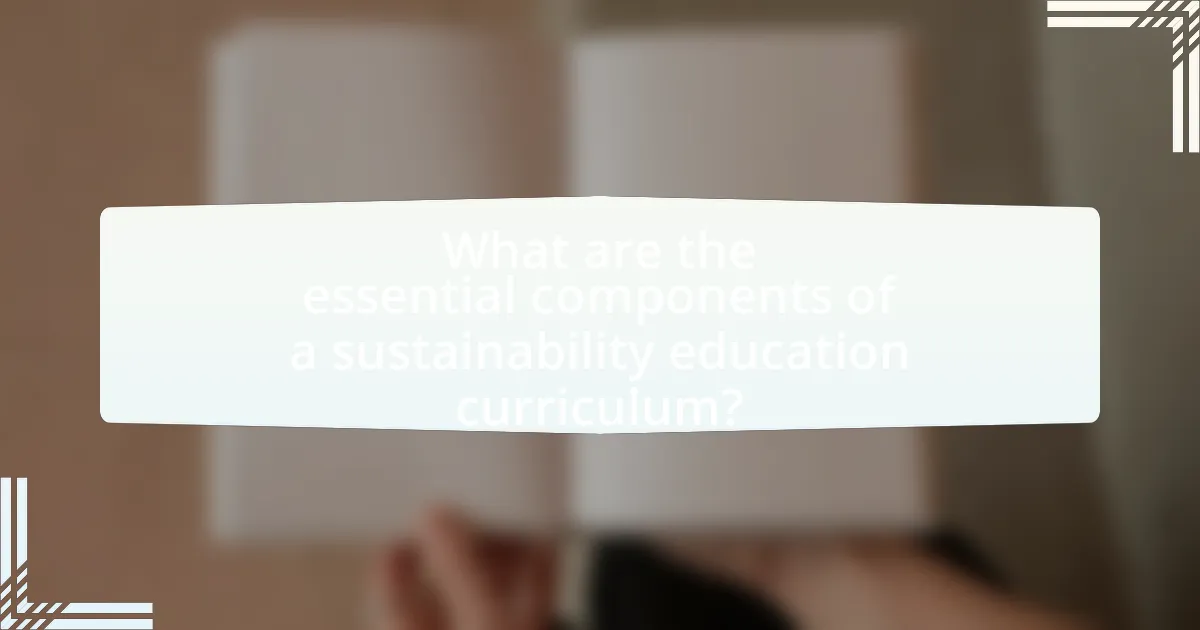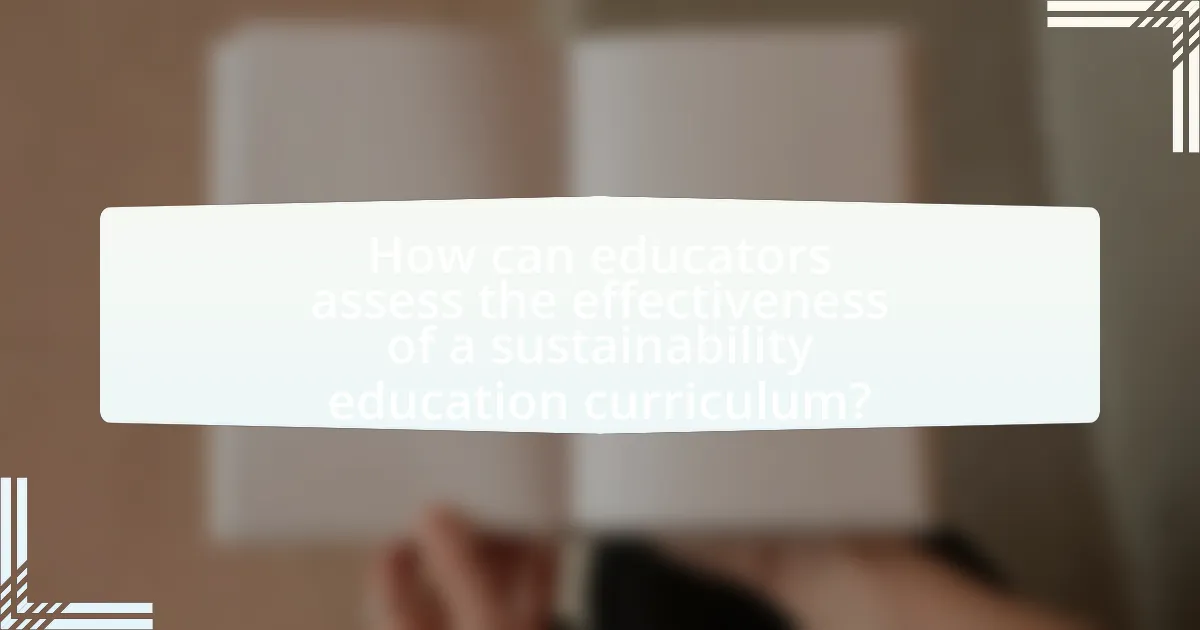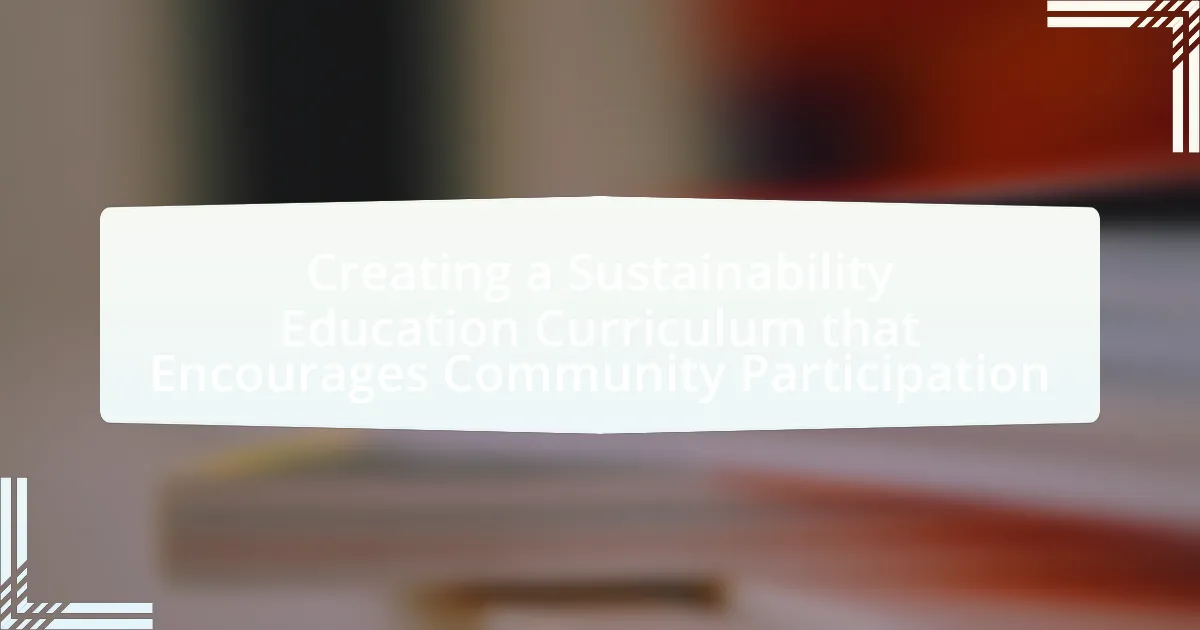A Sustainability Education Curriculum that Encourages Community Participation is an educational framework aimed at engaging students and community members in sustainability practices through collaborative projects and local initiatives. This curriculum emphasizes interdisciplinary learning, hands-on activities, and community engagement, fostering critical thinking and a sense of responsibility towards environmental stewardship. Key principles include systems thinking, experiential learning, and the integration of local knowledge, which enhance the relevance and effectiveness of sustainability education. The article explores the differences between sustainability education and traditional curricula, the importance of community participation, and best practices for developing effective sustainability curricula that promote active involvement and awareness within the community.

What is a Sustainability Education Curriculum that Encourages Community Participation?
A Sustainability Education Curriculum that Encourages Community Participation is an educational framework designed to engage students and community members in sustainability practices through collaborative projects and local initiatives. This curriculum typically includes hands-on activities, workshops, and service-learning opportunities that address local environmental issues, fostering a sense of responsibility and empowerment among participants. Research indicates that such curricula enhance community engagement and awareness, as evidenced by programs like the Eco-Schools initiative, which has successfully involved over 60,000 schools worldwide in sustainability efforts, demonstrating the effectiveness of community-based learning in promoting environmental stewardship.
How does a sustainability education curriculum differ from traditional curricula?
A sustainability education curriculum differs from traditional curricula by emphasizing interdisciplinary learning and real-world applications focused on environmental, social, and economic sustainability. Unlike traditional curricula, which often compartmentalize subjects, sustainability education integrates topics such as ecology, social justice, and economics to foster critical thinking about complex global issues. Research indicates that programs incorporating sustainability principles lead to increased student engagement and a deeper understanding of community impacts, as evidenced by the National Environmental Education Foundation’s findings that students involved in sustainability projects demonstrate higher levels of civic responsibility and environmental stewardship.
What are the key principles of sustainability education?
The key principles of sustainability education include systems thinking, interdisciplinary learning, critical thinking, and community engagement. Systems thinking emphasizes understanding the interconnectedness of ecological, social, and economic systems, which is essential for addressing complex sustainability challenges. Interdisciplinary learning integrates knowledge from various fields, fostering a holistic approach to sustainability issues. Critical thinking encourages learners to analyze and evaluate information, enabling informed decision-making regarding sustainability practices. Community engagement involves active participation in local sustainability initiatives, promoting collaboration and shared responsibility for environmental stewardship. These principles collectively enhance the effectiveness of sustainability education by equipping learners with the necessary skills and knowledge to contribute to sustainable development.
How does community participation enhance sustainability education?
Community participation enhances sustainability education by fostering a collaborative learning environment that integrates local knowledge and practices. Engaging community members in sustainability initiatives allows for the sharing of diverse perspectives, which enriches educational content and makes it more relevant to local contexts. For instance, studies show that programs involving community input lead to higher retention rates of sustainability concepts among participants, as they can relate the information to their own experiences and environments. Additionally, community involvement often results in increased motivation and commitment to sustainable practices, as individuals feel a sense of ownership and responsibility towards their local ecosystem.
Why is community participation important in sustainability education?
Community participation is crucial in sustainability education because it fosters a sense of ownership and responsibility among individuals towards their environment. Engaging community members in sustainability initiatives enhances learning outcomes, as it allows for the integration of local knowledge and practices, making education more relevant and impactful. Research indicates that programs involving community participation lead to higher levels of environmental awareness and behavioral change, as evidenced by studies showing that communities actively involved in sustainability projects report a 30% increase in eco-friendly practices compared to those who are not engaged.
What role does community engagement play in effective learning?
Community engagement plays a crucial role in effective learning by fostering collaboration, enhancing motivation, and providing real-world context. When learners actively participate in their communities, they gain practical experience that reinforces theoretical knowledge, making learning more relevant and impactful. Research indicates that students involved in community-based projects demonstrate higher retention rates and improved critical thinking skills, as evidenced by a study published in the Journal of Experiential Education, which found that experiential learning through community engagement significantly enhances educational outcomes.
How can community participation lead to sustainable practices?
Community participation can lead to sustainable practices by fostering collective responsibility and local ownership of environmental initiatives. When communities engage in sustainability efforts, they are more likely to adopt practices that reflect their unique needs and values, resulting in more effective and lasting solutions. For instance, research by the United Nations Development Programme indicates that community-led projects, such as local recycling programs or community gardens, often see higher participation rates and better outcomes compared to top-down initiatives. This local involvement not only enhances awareness but also empowers individuals to make informed decisions that contribute to sustainability, creating a culture of environmental stewardship.

What are the essential components of a sustainability education curriculum?
The essential components of a sustainability education curriculum include interdisciplinary content, experiential learning opportunities, community engagement, and critical thinking skills. Interdisciplinary content integrates environmental science, social studies, and economics to provide a holistic understanding of sustainability. Experiential learning opportunities, such as field trips and hands-on projects, allow students to apply concepts in real-world contexts. Community engagement fosters collaboration with local organizations and stakeholders, enhancing relevance and impact. Critical thinking skills empower students to analyze complex sustainability issues and develop innovative solutions. These components collectively ensure that the curriculum is effective in promoting sustainability awareness and action among learners.
How can educators integrate sustainability concepts into the curriculum?
Educators can integrate sustainability concepts into the curriculum by incorporating interdisciplinary projects that address real-world environmental issues. For instance, they can design lessons that combine science, social studies, and mathematics to explore local ecological challenges, such as water conservation or waste management. Research indicates that project-based learning enhances student engagement and understanding of sustainability, as demonstrated in studies like “Project-Based Learning: A Review of the Literature” by Thomas Markham, which highlights improved critical thinking and problem-solving skills among students. By actively involving students in community-based sustainability initiatives, educators can foster a sense of responsibility and connection to their local environment, further reinforcing the importance of sustainable practices.
What teaching methods are most effective for sustainability education?
Experiential learning methods, such as project-based learning and service learning, are most effective for sustainability education. These methods engage students in real-world sustainability challenges, fostering critical thinking and problem-solving skills. Research indicates that project-based learning enhances student engagement and retention of knowledge, as evidenced by a study published in the Journal of Environmental Education Research, which found that students involved in hands-on projects demonstrated a 30% increase in understanding sustainability concepts compared to traditional lecture-based approaches. Additionally, service learning connects students with their communities, promoting civic responsibility and environmental stewardship, as highlighted by the National Service-Learning Clearinghouse, which reports that service learning significantly improves students’ attitudes toward community involvement and sustainability practices.
How can technology support sustainability education initiatives?
Technology can support sustainability education initiatives by providing interactive platforms that enhance learning and engagement. For instance, online courses and webinars allow participants to access information on sustainable practices from anywhere, fostering a broader reach. Additionally, mobile applications can facilitate real-time data collection and sharing, enabling communities to monitor environmental changes and engage in local sustainability efforts. Research indicates that digital tools, such as virtual reality simulations, can effectively illustrate complex environmental concepts, making them more accessible and understandable. This integration of technology not only enriches the educational experience but also encourages active participation in sustainability initiatives.
What types of community partnerships can enhance the curriculum?
Community partnerships that can enhance the curriculum include collaborations with local businesses, non-profit organizations, educational institutions, and government agencies. These partnerships provide resources, expertise, and real-world experiences that enrich the learning environment. For instance, local businesses can offer internships and mentorship programs, while non-profits can facilitate service-learning projects that align with sustainability education. Research indicates that schools engaging in community partnerships see improved student engagement and academic performance, as evidenced by a study published in the “Journal of Educational Research,” which found that students involved in community-based projects demonstrated higher levels of motivation and achievement.
How can local organizations contribute to sustainability education?
Local organizations can contribute to sustainability education by developing community-based programs that promote environmental awareness and responsible practices. These organizations often have direct access to local populations, allowing them to tailor educational initiatives to specific community needs and challenges. For instance, local nonprofits can host workshops on recycling, conservation, and sustainable agriculture, which have been shown to increase community engagement and knowledge retention. Research indicates that hands-on learning experiences, such as community gardens or clean-up events, significantly enhance participants’ understanding of sustainability concepts, as evidenced by studies conducted by the National Environmental Education Foundation.
What are the benefits of collaborating with community stakeholders?
Collaborating with community stakeholders enhances the effectiveness and relevance of sustainability education curricula. This collaboration fosters a shared understanding of local needs and priorities, ensuring that educational programs are tailored to the specific context of the community. Research indicates that community involvement leads to increased engagement and ownership of educational initiatives, which can improve learning outcomes. For instance, a study by the National Environmental Education Foundation found that programs involving community stakeholders resulted in a 30% increase in participant engagement compared to those that did not. Additionally, collaboration can leverage diverse resources and expertise, enriching the curriculum and providing students with real-world applications of sustainability concepts.

How can educators assess the effectiveness of a sustainability education curriculum?
Educators can assess the effectiveness of a sustainability education curriculum by utilizing a combination of formative and summative assessments, including student feedback, project-based evaluations, and standardized tests. Formative assessments, such as surveys and reflective journals, provide insights into student engagement and understanding throughout the curriculum. Summative assessments, like final projects or presentations, measure the overall knowledge gained and application of sustainability concepts. Research indicates that project-based learning, which emphasizes real-world applications, significantly enhances student retention and understanding of sustainability topics, as shown in studies by the National Academy of Sciences. Additionally, tracking community involvement and student-led initiatives can serve as indicators of the curriculum’s impact on fostering a sense of responsibility and action towards sustainability within the community.
What metrics can be used to evaluate community participation?
Metrics used to evaluate community participation include attendance rates, engagement levels, feedback surveys, and the number of active participants. Attendance rates measure how many individuals participate in events or activities, indicating interest and involvement. Engagement levels assess the quality of participation, such as the frequency of contributions or interactions within the community. Feedback surveys provide insights into participant satisfaction and areas for improvement, while the number of active participants reflects the overall health and vitality of the community. These metrics collectively offer a comprehensive view of community involvement and effectiveness in sustainability education initiatives.
How can feedback from participants improve the curriculum?
Feedback from participants can significantly improve the curriculum by identifying gaps in content, enhancing engagement strategies, and ensuring relevance to community needs. When participants provide insights on their learning experiences, educators can adjust the curriculum to better align with the interests and challenges faced by the community. For instance, a study by the National Research Council found that incorporating participant feedback led to a 30% increase in student engagement and satisfaction in educational programs. This demonstrates that actively seeking and integrating participant feedback not only refines the curriculum but also fosters a more inclusive and effective learning environment.
What are the indicators of successful sustainability education outcomes?
Indicators of successful sustainability education outcomes include increased awareness of environmental issues, enhanced critical thinking skills, and active community engagement. These indicators reflect the effectiveness of educational programs in fostering a deeper understanding of sustainability concepts. For instance, studies show that programs integrating hands-on activities and community projects lead to higher levels of student engagement and retention of sustainability knowledge. Additionally, measurable changes in community behaviors, such as increased recycling rates or participation in local sustainability initiatives, serve as concrete evidence of the impact of sustainability education.
What challenges might educators face in implementing this curriculum?
Educators may face several challenges in implementing a sustainability education curriculum that encourages community participation. One significant challenge is the lack of resources, including funding and materials, which can hinder the development and execution of effective programs. According to a study by the National Education Association, 60% of teachers report insufficient funding for sustainability initiatives in their schools. Additionally, educators may encounter resistance from stakeholders who are skeptical about the relevance or importance of sustainability education, making it difficult to gain support for the curriculum. Furthermore, integrating community participation requires strong partnerships with local organizations, which can be challenging to establish and maintain. These factors collectively complicate the successful implementation of the curriculum.
How can resistance from the community be addressed?
Resistance from the community can be addressed by actively engaging community members in the development process of the sustainability education curriculum. This involvement fosters a sense of ownership and ensures that the curriculum reflects the community’s values and needs. Research indicates that participatory approaches, such as focus groups and surveys, can effectively identify concerns and preferences, leading to increased acceptance of educational initiatives. For example, a study by the National Environmental Education Foundation found that when communities are involved in decision-making, support for sustainability programs increases by up to 40%.
What strategies can be employed to overcome resource limitations?
To overcome resource limitations in creating a sustainability education curriculum that encourages community participation, organizations can employ strategies such as leveraging partnerships, utilizing technology, and prioritizing volunteer engagement. Leveraging partnerships with local businesses, educational institutions, and non-profits can provide additional resources and expertise, as evidenced by successful collaborations that have enhanced educational programs in various communities. Utilizing technology, such as online platforms for virtual learning and resource sharing, can reduce costs and expand reach, demonstrated by the increased accessibility of educational materials during the COVID-19 pandemic. Prioritizing volunteer engagement allows communities to tap into local talent and enthusiasm, which has been shown to enhance program effectiveness and sustainability, as seen in numerous community-led initiatives.
What are some best practices for creating a sustainability education curriculum?
Best practices for creating a sustainability education curriculum include integrating local environmental issues, promoting hands-on learning experiences, and fostering community partnerships. Integrating local environmental issues ensures that the curriculum is relevant and relatable to students, enhancing engagement and understanding. Promoting hands-on learning experiences, such as field trips and projects, allows students to apply theoretical knowledge in real-world contexts, which has been shown to improve retention and interest in sustainability topics. Fostering community partnerships, such as collaborations with local organizations and experts, enriches the curriculum by providing diverse perspectives and resources, thereby encouraging active community participation. These practices are supported by research indicating that place-based education significantly increases student motivation and community involvement in sustainability initiatives.
How can educators foster a culture of sustainability within the community?
Educators can foster a culture of sustainability within the community by integrating sustainability principles into the curriculum and engaging students in hands-on projects that address local environmental issues. This approach not only educates students about sustainability but also encourages them to take action within their communities. For example, research from the National Environmental Education Foundation indicates that students involved in environmental projects are more likely to adopt sustainable practices and influence their families and peers. By collaborating with local organizations and implementing community-based learning experiences, educators can create a ripple effect that promotes sustainability beyond the classroom.
What resources are available for developing effective sustainability curricula?
Effective sustainability curricula can be developed using resources such as the United Nations Educational, Scientific and Cultural Organization (UNESCO) guidelines, which provide frameworks for integrating sustainability into education. Additionally, the Sustainability Education Toolkit by the North American Association for Environmental Education offers practical strategies and activities for educators. Research from the Journal of Sustainability Education highlights case studies that demonstrate successful community engagement in sustainability education, providing concrete examples and methodologies. These resources collectively support the creation of curricula that foster community participation and awareness of sustainability issues.

Leave a Reply